
Carnivals
As a celebration of identity, integration, and freedom, carnival is one of the most important activities in popular Dominican culture. The most spontaneous and creative expressions of the national culture are conveyed from February to March with costumes and multicolored masks, characters and troupes, in an urban frenzy of joy and fun.
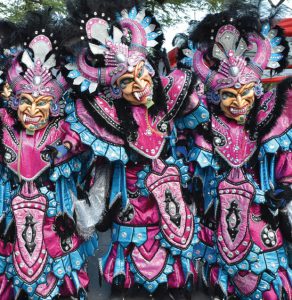 “Dominicans are happy people, who take advantage of any opportunity to enjoy and share pleasant moments… like their world-famous carnival,” according to the book “Lo Dominicano / All things Dominican,” published by GFDD. “The masks, the exaggeration, the sarcasm, the unusual, the satirical, the unprecedented, the daring, are fundamental parts of the carnival.”
“Dominicans are happy people, who take advantage of any opportunity to enjoy and share pleasant moments… like their world-famous carnival,” according to the book “Lo Dominicano / All things Dominican,” published by GFDD. “The masks, the exaggeration, the sarcasm, the unusual, the satirical, the unprecedented, the daring, are fundamental parts of the carnival.”
The characters and troupes recreate daily reality with exaggerated images and titillating language. The carnival cheerfully exposes the fears of communication, satirizes politics, hierarchies, social classes, and jumps on rules and prohibitions.
Did you know? “Lo Dominicano / All Things Dominican” (publication of GFDD, 2015) has an impressive and beautiful compilation of the main characters of the Dominican carnival, from the classic cojuelo devils to the cachúas and califé. You are invited to discover them.
Anything goes in this imaginative and exciting artistic show: blows, shouts, ridicule, and tricks. There is nothing missing. It contains, above all, what most scares us: death, disease, devils, social critique. It brings opposites together, it sublimates nature and relives history.
Two types of carnival are identified in the national tradition, that of the Carnestolendas (the period of three days that precede “Ash Wednesday” or the beginning of Lent), which has Spanish influence, and the Cimarron, associated with the cultural manifestations of African origin.
The first documented manifestations of Carnival tradition of European influence go back almost 500 years. Records prior to 1520 include celebrations in the days of San Andrés, San Juan Bautista, Corpus Christi and the anniversary of the city of Santo Domingo.
The “cojuelo devil” – legendary figure of a non-malignant lame and unruly spirit – has been the main character of the Dominican carnival since then, with different versions in each province. His origin has been traced back to the Middle Ages, of Christian and pagan influences, always linked to Lent. In the Americas version, he experiences syncretic mutations typical of the encounter of cultures.
Did you know? All the outstanding expressions of carnival that exist in the country are shown together on the last Sunday of February, or the first Sunday of March, at the Malecón, the popular promenade in the city of Santo Domingo facing the Caribbean Sea, in a great parade of floats and troupes.
Did you know? The carnival parties with the most marked identity characteristics are those of La Vega, Santo Domingo, Santiago, those of the municipality of Cabral, in the province of Barahona, as well as those of Bonao, San Pedro de Macorís, Puerto Plata, Sánchez Ramírez (Cotuí), San Cristóbal, Elías Piña, Salcedo, San Juan de la Maguana and Río San Juan.
You are invited to learn more about the Dominican carnival and many other popular Dominican celebrations, in the publication “Lo Dominicano / All Things Dominican,” of the Global Foundation for Democracy and Development (GFDD), which is available through Amazon here.
Other related links: http://www.carnaval.com.do
Carnival of La Vega
The carnival of the city of La Vega is possibly the oldest of the Dominican carnivals. It dates back to the sixteenth century, according to the chronicles of Fray Bartolomé de las Casas. It is considered the most organized and colorful of all, for the creativity of its masks, its costumes and the diversity of the groups, troupes, and the numerous artistic and cultural presentations that attract thousands of nationals and visitors annually.
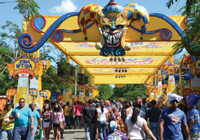 Its emblematic characters are the “diablos cojuelos” (cojuelo devils), – traditional in the Spanish culture – demons who love the hustle and bustle. In their modern version, the masked devils wear tennis shoes, gloves and balloons with which they hit the spectators if they come down from the sidewalks.
Its emblematic characters are the “diablos cojuelos” (cojuelo devils), – traditional in the Spanish culture – demons who love the hustle and bustle. In their modern version, the masked devils wear tennis shoes, gloves and balloons with which they hit the spectators if they come down from the sidewalks.
The traditional cloak suits covered in mirrors, jingle bells and sequins, in the Spanish style, and two-horned masks have evolved into a motley explosion of colors, with masks of protruding eyes, synthetic feathers, a profusion of horns, fangs, and of foreign fantasy images, some “Dominicanized” with goatees.
Did you know? The troupes or groups of Dominicans that are disguised under the same theme or cojuelo devils are classic in the carnivals. Each one spends months coordinating and planning their choreographies and costumes and creating masks and, during the carnival, they show an almost spiritual dedication to their group.
The masks of devils and animals continue to change in each version of the carnival, according to the fevered imaginations of the vegan experts “careteros” (crafters).
Each year, about two thousand cojuelo devils and more than eighty troupes entertain the crowd, from Padre Adolfo Street to Miraflores Park, where the last day of the parade, following an old tradition, the demons take off their masks.
More information can be found here: http://carnavalvegano.do
Other related links: https://www.livio.com/carnaval/
Carnival of Santo Domingo
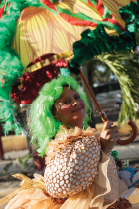 The neighborhoods carnival depart from the Enriquillo park, in the capital of Villa Francisca, with its classic cojuelo devils, accompanied by “La muerte en Jeep” (death on a Jeep), a masked skull; the popular “Califé”, a character dressed in a tail coat that composes humorous verses criticizing figures of the political and social life, followed by a chorus; the funny “Roba la gallina,” represented by a man disguised as a woman with a huge bust and butt, who, with an umbrella in his hand, asks for “food” in the grocery stores for his “chicks,” boys from the neighborhood waiting to be showered with goodies.
The neighborhoods carnival depart from the Enriquillo park, in the capital of Villa Francisca, with its classic cojuelo devils, accompanied by “La muerte en Jeep” (death on a Jeep), a masked skull; the popular “Califé”, a character dressed in a tail coat that composes humorous verses criticizing figures of the political and social life, followed by a chorus; the funny “Roba la gallina,” represented by a man disguised as a woman with a huge bust and butt, who, with an umbrella in his hand, asks for “food” in the grocery stores for his “chicks,” boys from the neighborhood waiting to be showered with goodies.
The neighborhood’s wit brings humor to the pain in “Se me muere Rebeca,” the story of an inconsolable mother who walks the streets crying for the illness of her daughter while asking for candy for the “girl,” who is usually a rag doll.
Did you know? As a show of street theater in the Dominican carnival, the troupe of San Carlos, a neighborhood of the city of Santo Domingo, stages the Spanish conquest and the extermination of the Taíno Indians.
“Los Africanos” is a troupe that remembers the blacks that were enslaved by the Spaniards at the time of the colony. Its characters cover their bodies with charcoal and burnt oil.
In Guerra, a municipality in the Santo Domingo province, the popular ingenuity is on display with the central character “El Negro de la Joya,” and the use of masks made of cans, cardboard, paper, and cotton.
The Carnival contains, equally, representations of the Arab immigrants, personified by the troupe of the “Ali Baba,” who dresses in ethnic costumes and parades with choreographed movements.
After the political division of the capital, the municipality of East Santo Domingo began to set up its own carnival on Sundays in February on the España Avenue. It had dozens of typical troupes, merengue, salsa, and prizes to stimulate citizen participation in its 9th edition (2016). The previous celebration (2015) was inspired by recycling and the protection of the environment.
Carnival of Santiago
The fun takes place on Sundays in February at the Monumento a los Héroes de la Restauración in Santiago, where the Lechones (piglets), as the people of Santiago call the cojuelo devils, congregate.
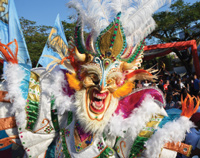 The Lechones or “macaraos” – a corruption of the word “enmascarados” (masked), used in el Cibao – wear disguises with hoods that evoke the Spanish style, particularly those with broad layers that reach up to the knee. The costumes, of three and four colors, are decorated with ribbons, mirrors, bells and tails that hang or are rolled.
The Lechones or “macaraos” – a corruption of the word “enmascarados” (masked), used in el Cibao – wear disguises with hoods that evoke the Spanish style, particularly those with broad layers that reach up to the knee. The costumes, of three and four colors, are decorated with ribbons, mirrors, bells and tails that hang or are rolled.
Did you know? The devils are differentiated by their masks. Three types identify neighborhoods with a deep-rooted carnival tradition: Los Pepines, La Joya, and Pueblo Nuevo.
The traditional masks of Los Pepines have smooth pointed horns and the mouth of a duck, which is broad at the base and has a round tip. The devils of La Joya put on their horns bristling with smooth thorns and a hunched mouth. Those of Pueblo Nuevo carry horns with flowers and balloons at their tips.
New groups have emerged as a result of urban growth and the expansion of slums; they enrich the festivities with masks of free themes, fantasy beings, animals and people, mostly made as the others, in molds of mud and papier-mâché.
Other outstanding characters are “Nicolás Den-Den,” a dancing bear, a children’s delight, chained and led by a tamer. Also, “El Hombre del Papelón,” who, disguised as a woman, moves his butt provocatively, prompting another character to whom he repeatedly shouts: “A que no me quemas el Papelón!” (I dare you to burn my Papelón!)
Santiago also has its group, Los Indios, La Muerte en Jeep, and El Baile del Muñeco. Its carnival tradition dates from 1795, it is linked to the religious festivities, and it was consolidated after the Restoration of the Republic in 1865.
As in other provinces, the Santiago Carnival of past centuries was socially stratified, with celebrations of the upper class in private clubs, while the poor had their party in the popular neighborhoods.
Carnival of Bonao
Whistles, bells, and balloons announce the arrival of more than 75 groups of “Macaraos” on carnival Sundays, who parade to the rhythm of different musical rhythms through the downtown streets of the city, wearing the traditional suit in satin, lamé, sequins and ribbons, with masks that simulate animal faces.
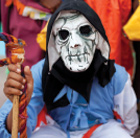 Bonao has created its own carnival identity since 1990, with the so-called Macaraos. It has won prizes for the creativity of the costumes and the floats of more than 60 groups and troupes. The following are among the most popular: los Guacamayos, los Malos, los Poderosos, las Hienas, los Pingüinos, los Bellacos, los Payasos, and los Kikos.
Bonao has created its own carnival identity since 1990, with the so-called Macaraos. It has won prizes for the creativity of the costumes and the floats of more than 60 groups and troupes. The following are among the most popular: los Guacamayos, los Malos, los Poderosos, las Hienas, los Pingüinos, los Bellacos, los Payasos, and los Kikos.
The celebration begins on the streets on the last Sunday of January and continues until the second Sunday of March. The carnival spirit of this city, as the elders remember, was maintained even in the economic precariousness of the 30s, when people made their costumes with old curtain fabrics, decorated with colored ribbons, whistles and mirrors.
They would take to the streets of the town from very early, with imaginative masks improvised by necessity, while the well-to-do would hold troupe contests at the Casino del Yuna, a private club.
Did you know? The Organizing Committee of the Carnival of Bonao (COCABO) is responsible for maintaining the carnival tradition as heritage of all sectors of the province.
More information may be found at: http://www.carnavalbonao.com
Carnival of Puerto Plata
The mask festival of the city of Puerto Plata has been transformed in the last ten years by a new generation of creative young people who have stamped on the carnival the symbols of the three cultures that contributed to forge the national identity.
The traditional cojuelo devil has reincarnated as “Taimácaro,” the central character of the carnival. Hundreds of taimácaros take to the streets by assault the days of carnival, disguised with masks of the cemíes, deities to which the Taíno indigenous people rendered cult. The costume, on the other hand, is typically Spanish – pants, shirts and capes – while the handkerchiefs and ribbons that tie to the sleeves allude in their diversity of colors to the religious mysteries of African culture. The snails, of important significance in Taíno mythology, adorn the trousers and symbolize the relationship of the locals with the sea.
Other groups and troupes that have participated in the last carnivals are: Dominicano Soy, Homenaje a la música, Los africanos, Los Espanta-pájaros, La Abanderada y su Batón Ballet, Cazadores de Cuatreros, and the classic diablos cojuelos and Roba la Gallina.
Read more at: http://www.puertoplata.com.do/es/cultura-y-sociedad/el-carnaval-en-puerto-plata
Carnival of Cotuí
The carnival of the city of Cotuí, in the Sánchez Ramírez province, is considered one of the most unique, due to the creativity of its costumes. The characters that characterize and synthesize the originality of the popular party are the Platanuses and the Papeluses, who have received recognitions and awards on numerous occasions.
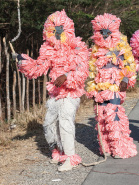 The platanuses wear costumes made of banana dried leaves tied with a rope that open like an umbrella when the character turns to the rhythm of the music. Their masks are made of dry higüero, some smooth, while others have painted combs, and goat and cow horns have been added more recently. The addition of color to the costumes, in recent years, has increased its eye-catching. Historian Francisco Rincón recalls that in his childhood, at the beginning of the 50s, the Cotuisans disguised themselves with newspaper; however, there are older references of the platanuses: great-grandparents of his family disguised themselves, between 1880 and 1890, with plantain leaves and a higüero mask with a shell that provides refuge for termites (Listín Diario/Cultura, February 17, 2016.)
The platanuses wear costumes made of banana dried leaves tied with a rope that open like an umbrella when the character turns to the rhythm of the music. Their masks are made of dry higüero, some smooth, while others have painted combs, and goat and cow horns have been added more recently. The addition of color to the costumes, in recent years, has increased its eye-catching. Historian Francisco Rincón recalls that in his childhood, at the beginning of the 50s, the Cotuisans disguised themselves with newspaper; however, there are older references of the platanuses: great-grandparents of his family disguised themselves, between 1880 and 1890, with plantain leaves and a higüero mask with a shell that provides refuge for termites (Listín Diario/Cultura, February 17, 2016.)
Did you know? The Papeluses – possibly derived from the platanus – are disguised with strips of newspaper, and also use masks of higüero, which have deformed mouth and eyes. A peculiarity of Los Papeluses is that two masks are placed, one on the face and another on the neck. It is believed that the arrival of brown paper to the grocery stores of the town gave rise to the disguise of the papeluses, which continued to be transformed with the use of newspaper, balloons, crepe and plastic.
The funduses are other characters born of popular creativity that use grocery bags to make all kinds of figures combined with masks.
The new generations have created groups such as Los Vikingos, Los Payasos, La Tribu, and also La Culebra y los Siete Pecados, la Litera de la Muerte, and el Mediodía. Cotuí also has its devils, who wear masks with a parrot’s beak and a pig’s nose, and trousers and a long shirt with bright red ornaments and small mirrors. They wear wings, imitating bats, stitched from the hem of the trousers that go up to the tips of the sleeves and open when the devils raise their arms.
Following the models of the Platanú and the Papelús, the groups make their disguises with waste materials within the reach of all pockets. Creativity makes good use of chicken feathers, sawdust, sheets of paper, plastic covers, horsehair, fabric strips, and bag fringes.
Carnival of Cabral
The carnival festivities of this municipality of Barahona, in the southern part of the country, are considered an example of the cimarrón masquerade. The origins of this town are traced to the slaves who populated the Bahoruco region and areas such as El Rincon, now Cabral, in the 18th century.
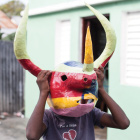 Its main characters are Los Cachúas, who wear green and red cloth costumes with black crosses and wings that resemble bats. The masks have crepe paper hair of different colors, and chins. That is where the name of Cachúas comes from. The ornaments include jingle bells and small mirrors, whose purpose is to ward off negative energies and attract positive ones. They carry whips made of sisal, maguey, and cabuya fibers, with which they hit the spectators and spread fear around them.
Its main characters are Los Cachúas, who wear green and red cloth costumes with black crosses and wings that resemble bats. The masks have crepe paper hair of different colors, and chins. That is where the name of Cachúas comes from. The ornaments include jingle bells and small mirrors, whose purpose is to ward off negative energies and attract positive ones. They carry whips made of sisal, maguey, and cabuya fibers, with which they hit the spectators and spread fear around them.
The carnival of Cabral is celebrated during Easter. The Cachúas fight with great fury on Holy Saturdays, and they burn a doll on the Monday after Resurrection, which represents the biblical character of Judas. They end their celebrations in the cemetery, around the tombs of deceased Cachúas.
Cabral also remembers the indigenous peoples, with the group Los Pirulíes, children disguised as “Indians” dancing in public wearing a costume made with coconut shell fringes.
In addition to Los Cachúas, the province of Barahona has the troupe Los Pintaos, whose members draw their bodies and faces with acrylic paint in intense colors and creative designs. This 1997 creation by Francisco Antonio Suero has debuted in the National Carnival Parade that takes place in the Dominican capital.
Carnival of San Pedro de Macorís
The Guloyas or Buloyas, of San Pedro de Macorís, are the most outstanding characters of the carnival of this province, with an original costume, layers of bright colors, jewels, mirrors and masks of devils made with long beards of peacock feathers.
Did you know? The Cocolos (as the descendants of immigrants from the Lesser Antilles are called) fill the streets of San Pedro with music, drinks, and food. Their dances are full of content, satire, humor, dreams, and nostalgia. They recreate their origins in their layers and costumes laden with mirrors and sequins. They perform various representations, such as the story of David and Goliath, accompanied by drum music, snare drums, cowbells, flutes, and triangles. They weave ribbons, walk and dance on stilts to the beat of sticky rhythms of African origin.
The Guloyas, declared Intangible Oral Patrimony of Humanity by UNESCO, represent the culture of black immigrants from the English Antilles, who make their presentations during Christmas and the National Carnival Parade. Their celebrations convey positive social messages, highlight the triumph of Good over Evil, of the oppressed over the oppressors.
Other related links:
http://www.educando.edu.do/articulos/estudiante/carnaval-de-san-pedro-de-macors/
http://www.macorisserie23.com/san-pedro/los-guloyas.html
Carnival of San Cristóbal
Promoter of Dominican ethnic roots and of educational themes, the carnival of the province of San Cristóbal was strengthened with the work of theater and musical groups in 1980, validating the efforts of Julio Heredia de los Santos, who tried to keep alive the celebration in previous decades.
In this way, the essence of the carnival was recovered, with its troupes of diablos cojuelos, Los Africanos, adorned with multicolored costumes; Los Indios, Los Galleros, Las 21 Divisiones, el Califé, los Roba la gallina, and una Muerte risueña, adorned with ribbons and rattles.
Carnival of Salcedo
The carnival in the province of Salcedo has developed its own identity over the years, with new characters and groups. Their “macarao” devils show colorful costumes, made in crepe paper of intense color, probably the colors of stronger tones of the national carnival.
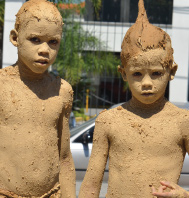 Their varied masks simulate animals of the region, such as bulls, pigs, goats and horses. Two groups move away from the traditional ones: that of Las Cebras, made up of women, and El Veterinario y sus Animalitos, which are children between two and twelve years old disguised with masks of the “patients” that they treat.
Their varied masks simulate animals of the region, such as bulls, pigs, goats and horses. Two groups move away from the traditional ones: that of Las Cebras, made up of women, and El Veterinario y sus Animalitos, which are children between two and twelve years old disguised with masks of the “patients” that they treat.
Troupes that enrich the carnival come out of what the Salcedenses call “Cuevas,” such as Los Cabros, Los Montro, Casa Grande, Los Duendes, Las Gárgolas, Los Escorpiones, Los Hechiceros, El Viejo y la Vieja, and El Loco de la Amargura.
More than 33 groups register annually at the Salcedo Carnival Union (Unión Carnavalesca de Salcedo (UCASAL)) to participate in the event, which begins on the first Sunday of February and extends until the first Sunday of March.
The celebration concludes with a ritual staged by the spectators, who rush on the macaraos to destroy the costumes and scatter the colorful papers through the streets, an act of dispossession that has been interpreted as a desire to put an end to the old and to foster the new in upcoming celebrations.
Elías Piña Carnival
The rise of the black slaves is commemorated in the wild carnival of Elías Piña, with representations of troupes, whose themes allude to the freedom and identity for which the Africans subjected to slavery fought.
Another manifestation of the Cimarron carnival is the presence of the Gagá dances, which combine festive and religious elements. In communities of the province, such as El Llano, singular carnival expressions have been developed, such as Las Máscaras del Diablo (the Devil’s Masks), which are placed in the courtyards of homes, as sentinels, on the evening of Holy Thursday.
Made of corrugated cardboard, goat horns, vegetable waste and chicken feathers, the masks conceal the faces of men who disguise themselves dressed as women, starting on Good Friday, and go out on the streets to terrorize people with the blows of their whips.
In the past, these characters concluded their carnival with a rite of fertility, burning the masks in the mountains and spreading the ashes among crops, to the beat of drums.
Carnival of San Juan de la Maguana
The carnival of San Juan de la Maguana recalls the origins of the Dominican people with indigenous, Spanish and African troupes.
 The indigenous profile is staged with accessories, feathers, dances, while the Spanish profile is portrayed with representations of the discovery and founding of the town of San Juan. African culture is present in music, dances and in traditional manifestations, such as sticks, olivorismo (Liborista movement) and the brotherhood of the Holy Spirit.
The indigenous profile is staged with accessories, feathers, dances, while the Spanish profile is portrayed with representations of the discovery and founding of the town of San Juan. African culture is present in music, dances and in traditional manifestations, such as sticks, olivorismo (Liborista movement) and the brotherhood of the Holy Spirit.
Organized by the City Council and civil society, the celebration begins in February and ends in March. A large parade leaves from Plaza Anacaona to Duarte Park, in the center of the city, displaying a variety of costumes and masks, among which are Las Tifúas, decorated with asphalt and horsehair, and Los Cocorícamos, who carry an entire horse or donkey skull.
Carnival of Río San Juan
This small town of 15,000 inhabitants, located in the province María Trinidad Sánchez, has a marine carnival that is unique in its class, inspired by the species of the sea. There is nothing like it in the entire Dominican Republic.
Its roots date back to 1997, and it takes place on a platform positioned on the waters of the Grí Grí Lagoon. The troupes, called “Carnamares,” parade around to the sound of music, with colorful masks decorated with fins, corals and shells, in costumes of whales, crabs, octopus, jellyfish, lobsters and imaginary sea monsters.
Local artists make costumes using clay molds that they reproduce on cork and paper, to which they attach shells, fish scales, coral, and shark teeth.
In recent years, the crown of the carnival queen has been made with black and pink corals, larimar, seawater, on a gold and silver base, a design by Architect Persio Checo, and made by Jeweler Daniel Sánchez.
The “Carnavarengue”, from Río San Juan, attracts domestic and foreign tourists who enjoy the waters, among fish, iguanas, mangroves and aquatic birds. Every night the celebration evokes an encounter with the sea, and also with livestock and agriculture, because it has a distinctive cuisine with dishes of Creole chicken, chambre campesino, roast chicken, coconut fish, and wine goat.
In Search of Identities
There are other provinces in the process of redefining their carnival identity. From a tradition of the cojuelo devils, the popular carnival of La Romana, located in the eastern part of the country, evolves to the painted faces – masked faces – that are valued because of the creative diversity of their expressions, designs and colors. One that has appeared recently is the “Papabuey,” a symbiosis of the parrot and the oxen, considered “icons of the sugar industry.” Celebrities such as Juanico Robinson, with their typical old suit, broad-brimmed hat, walking stick and powdered white face, continue as part of the tradition. In addition, the traditional troupe of Los Indios, the street theater of the Guloyas, and the Gagá with luases and metresas, voodoo deities.
In the same region, in the municipality of Yerba Buena, in the province of Hato Mayor, the Marimantas have captured the attention of the country with their suits made of tree branches, cow leather masks and heads covered with a shell that provides refuge for termites. “El Doctor” is another outstanding character, which is painted in various colors, carries a briefcase, and wears orange peel glasses held by wires.
Hato Mayor has developed its own carnival personality, based on its condition as a livestock province, with the character “Cabatoro,” a representation of the cow and the horse.
In the northern city of Moca, the carnival establishes its new identity with the “Animáscaros,” groups with names and costumes of animals: owls, dragons, coyotes, vultures, spiders, panthers and unicorns.
Traditional characters are preserved, such as the blue devils and the “Jinchaíto de Moca.” The latter characterizes the nickname that is given to Mocanos since the beginning of the last century, at a time when the factions of the Spaniards established in the community of Juan López began to swell after drinking the polluted waters of the river, according to Mocano historian Julio Jaime Julia. With time, the nickname of the “hinchaítos” (swollen) spread to all Mocanos.
The peninsula of Samaná has marine devils, with big masks, whose horns resemble corals, and typical troupes, like Los Indios, the burials and the African dances.
The Montecristi province, in the northwestern part of the country, has its famous bulls as the central characters, with colorful costumes and masks that recreate the faces of pigs, with ears made of tubes of tires. The opening of the eyes is covered with a metal mesh, and they wear rope whips. They face Los Civiles, in daily clothes and without masks. They fight in duels with great fury, and the Civil who manages to pull off the mask or the disguise of a bull is hailed as a hero, for his courage.
In the Cibao province of Valverde Mao reigns the Abechisa mask, which combines characteristics of the bee, the goat, and the toad, animals that play important roles in the life and the economy of the people from Mao.
To the South, the city of Baní has developed one of the best national troupes, centered on the Roba la Gallina character.
In the heights of the Cordillera Central, the Montrojuelos, from the municipality of Constanza, have established a definite identity to their carnival, which was nurtured for many years by the characters of La Vega, even in the use of second-hand costumes.
The Montrojuelos began to take shape in the early 90s, when the idea of making a carnival with the elements of the history and culture of Constanza germinated. They radically changed the masks in the process, making them so large – up to five feet high – that their pieces must be assembled.
Masks over masks of gruesome monsters, of tigers, dragons, monkeys and elephants, are built on a plaster base covered in newspaper and cement. The costumes are made with waste from their surroundings, fiber bags, plastics, soft drinks caps, and they give Constanza its own carnival personality.
Sources of references and other links:
- Lo Dominicano /All Things Dominican, 2015, Global Foundation for Democracy and Development (GFDD).
- www.folkloredominicano.blogspot.com
- www.identidadsanjuanera.blogspot.com
- www.lascalientesdelsur.net
- www.m.wikipedia.org/riosanjuan(municipio)
- www.educando.edu.do
- Centro León www.centroleon.org.do


